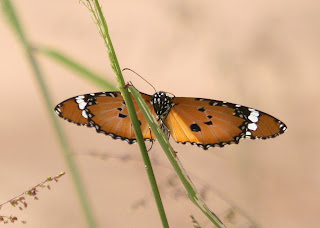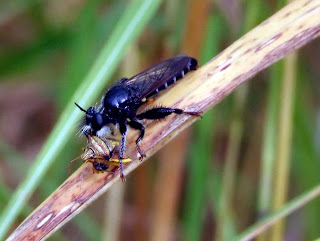Brown-rumped Bunting
Sun Lark
This Sun Lark was giving a quiet, unexceptional song from the ground, whilst overhead we could hear the "brrrrrr" wing-clapping of Flappet Larks. The Sun Larks were on disturbed open, gravelly ground where we also saw about 10 African Quail-Finches, a species that is to be expected here, though I'd previously seen them only at Nyamlel, Northern Bahr el Ghazal.
There were some attractive butterflies and other noteworthy creatures. Andrew identified these and took all the photos apart from the first three.
Male African Monarch Danaus chrysippus
Andrew commented about the African Monarch that: 'the fourth large circular spot on the wing is actually a scent gland that releases pheromones. The butterfly is poisonous or distasteful to birds - the larvae feed on Calotropis procera and various of the Asclepidaceae and sequester the poisons.'
Colotis spp.
Long-tailed Pasha or related species
Crimson tip Butterfly Colotis danae
Unidentified Acraea spp butterfly
Pair of unidentified mating skippers (family Hesperidae)
Giant red velvet mite Trombidium grandissimum
Andrew noted that 'the giant red velvet mite......is believed in some parts of India to have aphrodisiac properties - from the red oil squeezed from their bodies......Trombidium grandissimum is the largest mite in the world and predates termites'.
Robber fly (family Asilidae) with prey, a pentatomid plant bug
So a fascinating trip. Many thanks to Andrew for his identifications and other information.










No comments:
Post a Comment